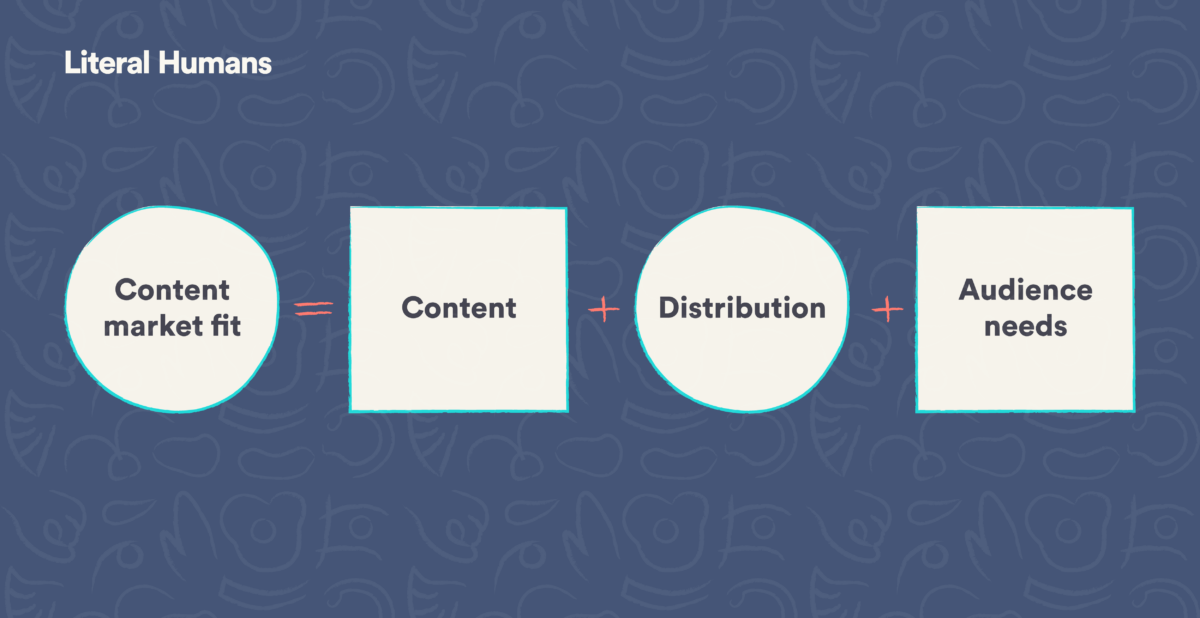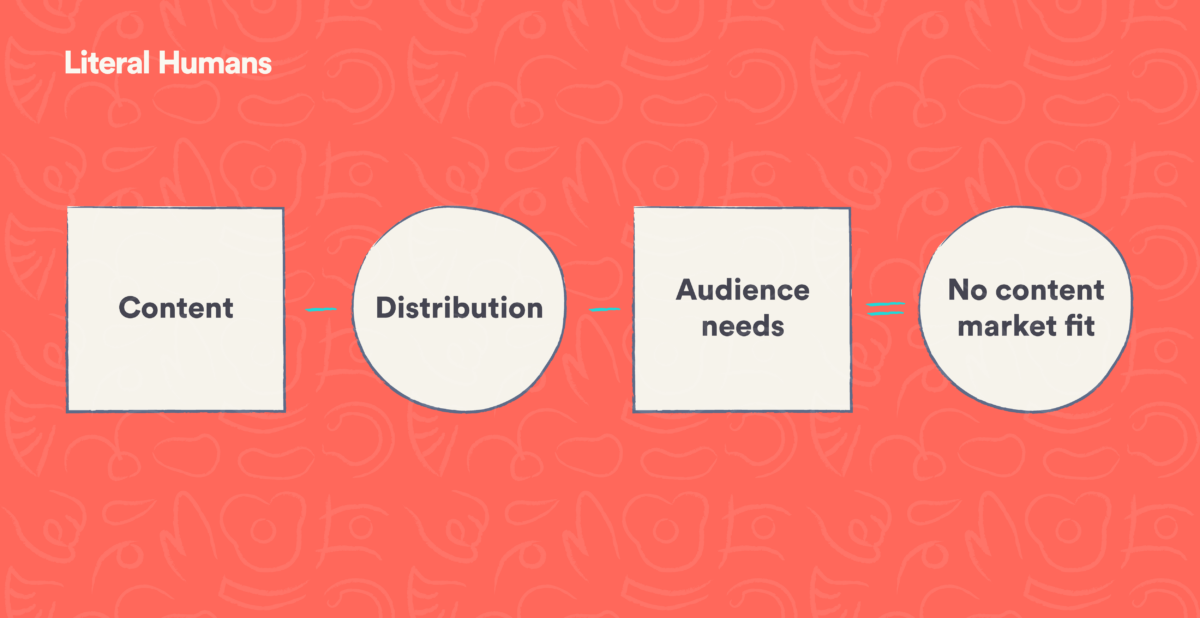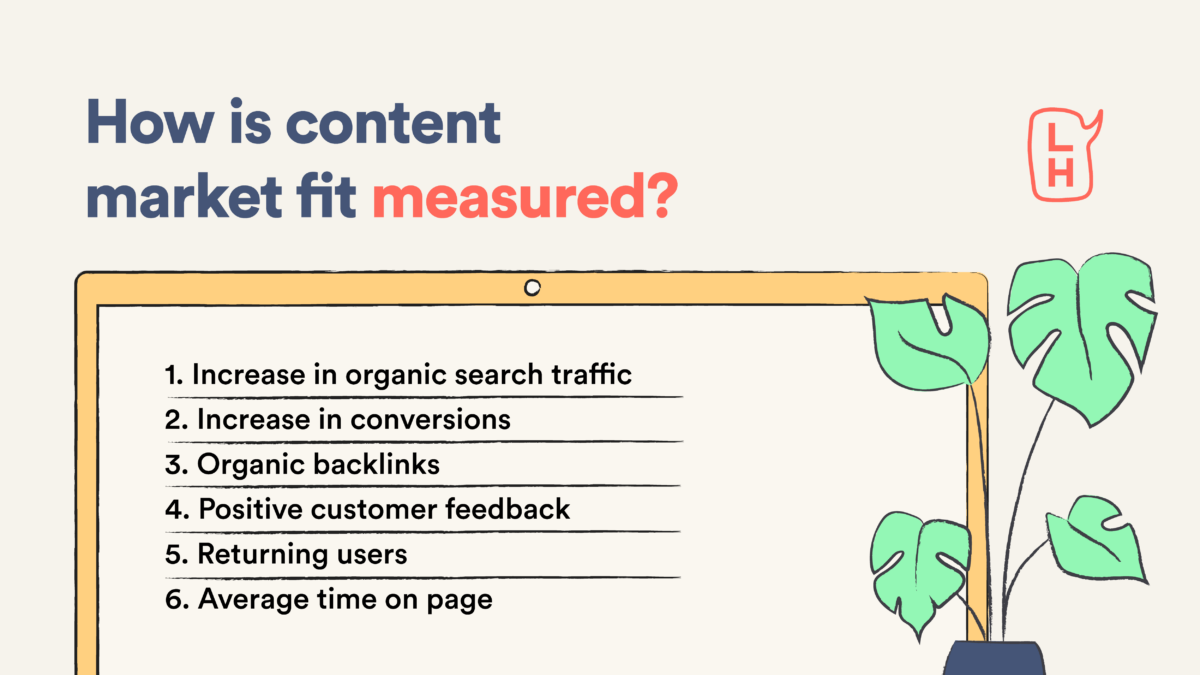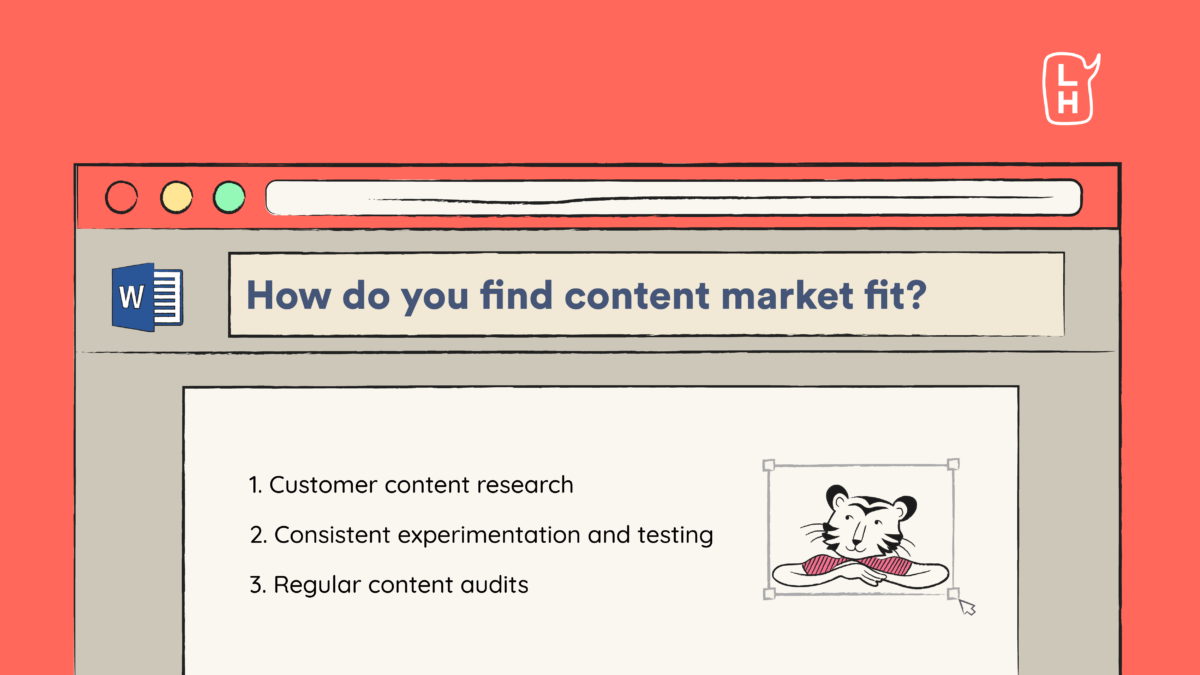Have you ever ordered clothes online, visualized how the outfit will look in your head, only to receive the clothes, try the clothes on and you realize they don’t fit? Yeah, same.
It’s a frustrating experience, as you replay the ideas and plans you had for your outfits in your head, while looking at the sleeves of your top draping over your wrists.
This concept plays out a lot in the startup world, whilst founders certainly aren’t planning outfit lookbooks, they do visualize the product they’re going to build, imagine the sales they’ll rake in and sometimes when the product hits the market, they find that it doesn’t fit—the company doesn’t have product market fit.
But there’s also another type of market-fit that startups aren’t always aligned with. It’s called content market fit. A lot of startups are creating content that doesn’t align with what the audience (customers and prospects) wants.
As a content marketer, I’ve seen and experienced this firsthand. I’ve worked with companies that have crafted lengthy content strategies coupled with lofty plans to rapidly distribute content. But the company’s expectation for the content doesn’t always meet the reality.
The content generates fewer conversions than anticipated because the content doesn’t fit what the audience is looking for. The company doesn’t have content market fit.
Despite the fact that over 39% of companies allocate 31-50% of their marketing budget for content marketing, many companies don’t have content market fit. That’s a lot of money to spend on content that doesn’t fit your customers.
However, most companies don’t realize that they don’t have content market fit. Unlike product-market fit, which is easier for companies to determine, as the indicators are more obvious— an increase in ARU, decrease in customer churn and onboarding legacy clients etc.
It’s hard to establish whether a company has content-market fit as the indicators are more subtle. That’s why I’ve put together a decision tree for you to assess whether your company has content market fit. I’ve also included some pointers to help you find content market fit.
Let’s dive in.
What is content market fit?
I suppose this is the million dollar question—what exactly is content market fit? I’m afraid to say that the answer isn’t quite clear cut.
Over my years as a Content Marketer, I’ve realized that “content market fit” is a double entendre. There’s two distinct meanings and interpretations of the term “content market fit”, depending on who you ask. Let me explain what I mean.
The double entendre of content market fit
The first meaning of content market fit refers to producing content that meets your audience’s needs. This definition can be best explained by asking “Does your content fit your market?”. This definition solely refers to the content and the market’s needs.
The second definition of content market fit refers to assessing whether content marketing is the right fit for your company. The second definition can best be explained by asking “Are you fit to bring your content to the market?” The second definition refers to content and the company.
The definition I’m referring to throughout this article is the first definition “does the content fit your market?” However, I think it’s important that I shed light on the other definition of content market fit too, “Are you fit to bring your content to the market?”

Is content marketing the right fit for your company?
I believe in two things when it comes to B2B SaaS companies and content marketing:
- Every B2B SaaS company should consider content marketing as a marketing strategy
- Content marketing is a cross-collaborative effort across Product, Marketing and Sales.
The question for B2B SaaS companies becomes is content marketing the right fit for the company at that particular time. Here are some points for you to consider before you decide you want to get started with content marketing.
No paying customers
Some marketers will say that a very small pre-seed startup that doesn’t have any paying customers shouldn’t focus on content marketing immediately. Their priority should be using faster marketing strategies like outbound marketing to bring them closer to getting paying customers.
However, I think that this is false. It’s never too early to start with content marketing. Whilst I think that a company with no paying customers may not be fit to financially invest in SEO content (paying for SEO tools, hiring freelancers or a content agency), this doesn’t mean the company shouldn’t focus on content marketing.
The company can benefit from writing posts about the company’s mission and creating thought leadership content.
No solid ICP
I’ve worked with companies that were not ready for a content agency and/or freelancer cause they didn’t understand their ICP and positioning and quickly churned after onboarding. This ends up being a waste of time and resources for both the company and the content agency.
If a company hasn’t defined their ICP, the company shouldn’t focus on SEO content. SEO content is dependent on keyword research, and for keyword research, you need to know the keywords your ICP is looking for.
If you don’t know who your audience is, you won’t know what keywords they’re looking for and what their needs are. You can’t create content for them.
Instead of SEO content, companies with no solid ICP should focus on thought leadership content and product-led content. Content that focuses on the product’s features and the mission of the company.
A broken product experience
A broken product experience is a common growth problem in SaaS. A poor product experience can lead to high rates of customer churn, so whilst a company invests money in content marketing, the company also loses money from customer churn.
It’s counterproductive to dedicate time and resources on customer acquisition without focusing on customer retention. Then to recoup costs, the content marketing department gets axed.
A poor product experience is also counter productive to product-led content such as YouTube tutorials or walkthrough blog posts. Creating content that drives product awareness and aims to generate leads whilst the product experience needs improvement won’t lead to trial signups and MQLs.
Content literacy
If a company doesn’t have a baseline understanding of how content marketing works, it makes content marketing difficult as a marketing strategy for the company.
There tends to be a mix of unrealistic expectations and frustration due to a lack of understanding about content marketing and an overarching desire to meticulously tie revenue to content. This makes it hard for the content marketer to execute and lead the content marketing efforts.
I also know many Content Marketers can relate to working with companies who have a lot of misconceptions about content strategy and this leads to a frustrating experience between the content marketer and the company. Having an understanding of content marketing will help companies manage their expectations of how the content can perform.
Patience
Let’s be really honest here—many companies are not patient when it comes to content marketing and many companies have unrealistic expectations. Content marketing can yield fantastic results but it takes time. A lot of companies invest the resources and finances into content marketing but aren’t willing to invest their time.
If a company’s growth goal is to reach as many customers as quickly as possible, then content marketing isn’t a right fit for the company at that time. It’s important that a company seeking to invest in content marketing is patient and has realistic expectations of what success they’d like to achieve.
Now that I’ve got that out of the way, let’s answer the question: what is content market fit?
Content market fit: aligning your content and distribution to your market
Simply put, content market fit is when the content you produce and distribute aligns with what your audience needs. Your content is valuable and educates your audience, and sometimes your content provides a solution to what your audience is looking for.
Let’s talk more about the content you produce and distribute.
Content marketing is more than just writing blogs, you can create YouTube videos, host webinars, podcasts and even audio blogs. Usually, companies use a range of content formats to market their product. Content market fit is when you have found the right format for your audience.
Alongside the right formats, it’s important to ensure that you use the right channels to distribute your content. Do you understand where your audience lives?
For instance, let’s take a look at YouTube. Many B2B brands have tried their hand at YouTube but very few have been successful, simply because that’s not the format of content for their audience’s wants and needs. One B2B brand that excels at content marketing on YouTube is Notion.
Notion creates different types of video content in multiple languages, ranging from tutorials, customer stories and Hot Seat webinars. The Hot Seat webinars are also repurposed into blog posts. Notion’s English videos generate over 5,000 views per video with some videos reaching over 20,000 views.
Notion understands their audience and knows where their audience lives. They know that their audience benefits from video tutorials and webinars and know that their audience will come to YouTube for this type of content.
Understanding your audience is key to achieving content market fit. Shorthand, the collaborative digital storytelling platform decided to kill their blog and move to a magazine. After achieving much success with SEO, the Shorthand team decided that their audience, creatives and digital publishers, didn’t need a blog but needed a magazine.
This is a great example of finding content market fit. Choosing the right type of content and distribution channel for your audience’s needs.
The content market fit formula
Take a look at this formula:
Content market fit = Content + Distribution + Audience needs

Let’s imagine you have awesome content but you haven’t quite mastered your distribution channels, your audience isn’t seeing your content, which means you don’t have content market fit.
A lot of companies fall into this category—a great team of writers on deck, a well thought out list of keywords, a convincing strategy plan but weak distribution. Posts aren’t repurposed to visual infographics that can be shared on Linkedin and companies aren’t sharing customer newsletters with prospects that have entered the sales pipeline.
Alternatively, you only post infographics rather than short 150-300 word case studies that demonstrate your product’s value, so prospective customers can’t see how your product will solve their problems.
In either case, you’re not meeting your audience’s needs.
Our formula looks like this:
Content – Distribution – Audience needs= No content market fit

All three factors need to sync to qualify as content market fit.
Content market fit doesn’t happen overnight and one successful blog article isn’t necessarily an indicator of content market fit. Content market fit is a constant. Are you consistently producing content that captures your audience’s attention? Are your readers engaged with your content?
Companies with content market fit
When it comes to talking about companies with content market fit, there are three companies that come to mind. Here’s why:
86 Repairs
86 Repairs is a repair and maintenance management platform built for the restaurant industry. Their core ICPs are restaurant owners and restaurant managers. 86 Repairs produces content in the right format, SEO driven content that appeals to restaurant owners such as repairs guides for ice machine repairs to oven grease cleaning methods.
Secondly, 86 Repairs know where their audience lives and they use the right channels to distribute their content. 86 Repairs don’t rely on Twitter as a distribution channel because they know that their audience aren’t Twitter users.
Their users are likely to be Facebook and Instagram users, so 86 Repairs repurposes their blog posts into infographics that are distributed on Facebook and Instagram.
Most importantly, their content marketing strategy is paying off and yielding fantastic results, a large proportion of their organic inbound traffic comes from SEO, according to Libby Peck, the Senior Content Manager.
Dovetail
User research software Dovetail leads the charge when it comes to producing content for people who do research. Dovetail has an interesting yet unique approach to content marketing, with a company blog and a standalone publication called the Outlier. Dovetail has content market fit, they create and distribute content that meets their audience’s needs.
Dovetail has seen phenomenal growth from their company blog and still focuses on SEO to drive organic traffic. But they’ve decided to create a standalone publication to connect deeper with their audience and shed light on a wide range of stories from user research to technology.
What’s interesting about Dovetail’s Outlier, is that although it’s a standalone publication, which is one content format, Outlier is broken down into different forms of content such as audioblogs, long form and short form articles and videos.
Workforce.com
Disclaimer: I used to write for workforce.com. Maybe I’m being a little self-promotion-ey here!
All bias aside, workforce.com unequivocally has content market fit. Workforce.com is a shift scheduling software platform for shift workers in a wide range of industries such as temporary staffing agencies, restaurants and hospitals. Their core ICPs are restaurant owners and managers, and HR coordinators at temporary staffing agencies.
Workforce.com produces the right type of content for their audience, TOFU SEO driven content. Personnel with shift staffing issues are problem aware and often resort to Google to find solutions to their problems by typing TOFU keywords like “employee time theft” or “shift scheduling for restaurants”.
Workforce.com focuses on this type of content, organically ranking high for a wide range of TOFU keywords related to shift scheduling and staff operations. Workforce.com provides valuable, informative content using the right distribution channel, organic search to meet their audience’s needs and provide solutions to their audience’s problems.
Now you know what content market fit is, let’s talk about how you can measure content market fit.
How is content market fit measured?
Here are the key metrics that reveal whether you have content market fit.

Increase in organic search traffic
An increase in organic search traffic is the key objective for a lot of content strategies and it’s the first step required to achieve content market fit. You need to be able to reach your audience to demonstrate how your product meets their needs. A consistent increase in organic traffic suggests that your content is high quality, well optimized and ranking for your target keywords.
Organic search traffic is driven by user intent, users are looking for solutions to their problems or general information about a topic. Whilst no one knows explicitly how search engine algorithms work, an increase in organic search traffic does indicate that your content meets the user’s search intent, which is a factor of content market fit.
Increase in conversions
An increase in conversions is arguably the biggest indicator of content market fit. Firstly, if readers are converting from your content, this means that the content is distributed effectively to reach your intended audience.
Secondly, the content meets your audience’s needs and demonstrates the value of your product to the point where they feel that they need to convert and try your product. Conversions are also a great way to track your content marketing ROI, you’ll be able to see the impact that your content has on your business performance.
Organic backlinks
Organic backlinks act as a contributing factor to content market fit rather than an explicit measurement of content market fit. Organic backlinks assert that your content is high quality, authoritative and valuable.
If another content marketer organically places a backlink to your content, it means that they think your content adds value to the website and can be beneficial to their audience. Plus, organic backlinks double up as a distribution channel, readers may click on the backlink and find your content interesting.
Positive customer feedback
Have you ever had customers reach out to you and say “wow that was a great read”, or “that was so informative, thank you”? This shows that your customers are enjoying your content and it’s valuable.
Or maybe you scrolled through Linkedin and saw your customers praising your content and referring an article to their audience. These are all signs of content market fit; not only are you meeting your audience’s needs, but you’re also aligning your distribution. Your customers are promoting and distributing your content.
Returning users
Nothing indicates an enjoyable experience with a product or service more than a return visit. The same applies to content. If your readers are coming back to your blog naturally, then it’s safe to assume they enjoy your content. Your content is valuable and you’re meeting your audience’s needs.
Returning users are also a heavy indicator that a user is about to convert, after all, B2B buyers read an average of 13 pieces of content before converting. So if your analytics show a lot of returning users, you’re on the right track.
Average time on page
The average time on page can indicate how long readers are staying on your page and reading your content. Many people tend to skim through blog posts and spend an average of 54 seconds on a page.
If you find that your average time on page is higher than 54 seconds, this suggests that your readers are enjoying your content and are engaging with your content. You’re on track to finding content market fit.
How do you find content market fit?
Finding content market fit is a gradual process that requires a lot of research, experimentation and testing. This means that you’ll have to try out different content formats and distribution strategies to see what resonates with your audience and performs well.
Make sure you document your strategies and perform regular content audits to gauge the results of your experimentation.
Sometimes, you can’t find content market fit by yourself, and you need some assistance. After all, content marketing is a team sport. A content marketing agency can help you find content market fit.

Customer content research
Customer content research is your starting point if you want to find content market fit. You won’t know what type of content you should produce if you don’t research your audience. You need to know what mediums your audience uses to consume content, what formats they like and so on.
Ask your customers where they go to find information, what platforms they use and trust as verifiable sources of information. Ask your customers their opinion, what makes a piece of content good?
Use the answers from your customer content research to form the backbone of your content strategy. If your customers use forums like Github or Quora as sources of information, you can list that as a distribution channel. Likewise if your customers prefer short pieces of content, include short form content as the types of content you’ll produce.
You also need to research the current content on the market, what are your competitors doing, are there any gaps in their current content? With these findings, you can find unique angles to exploit and ways to create better content.
Consistent experimentation and testing
Consistent experimentation and testing doesn’t mean that you should haphazardly launch different types of content campaigns across every and any platform at the same time.
Focus on one or two types of content campaigns, experiment with the types of content you produce and your distribution channels and assess what is working and what isn’t. Cut out what isn’t working and continue to focus on what is working.
For instance, let’s imagine a HR SaaS company has started content marketing. They’ve spent 18 months producing and distributing content that they believe will attract their ICP, HR decision makers at enterprise companies.
They’re getting a lot of organic traffic and interest in their content, but instead of attracting HR decision makers, their content attracts the end users of their product, employees and it’s not leading to many conversions.
Their content doesn’t align with their ICP, they don’t have content market fit. Although they’re producing great content and their distribution is good, they’re not meeting their audience’s needs. Despite the overall increase in organic traffic, they’re not reaching the target audience for their product.
They need to restrategize and reevaluate your content topics to reach your ICP. Once they’ve redefined your strategy, it’s time to test, again.
This is how you find content market fit, Strategize, Test, Rinse, Repeat.
Regular content audits
You won’t know what is working if you don’t audit your content. With content audits, you’ll be able to analyze and track all your important metrics like organic search traffic, returning users, average time on page.
Every content marketer has different ideas of how often content audits should be performed but I would suggest quarterly. This gives your content enough time to stack up metrics like organic search traffic and conversions.
If you audit your content weekly, you might find that your numbers look too low. If you audit your content bi-yearly, you might find that the content strategy isn’t working at all and you’ve wasted a lot of time and resources on something that isn’t working.
Quarterly gives you enough time to have an accurate view of what’s working and also gives you enough time to pull the plug if you realize that it’s not working.
With content audits, you’ll also be able to view your content’s performance and you’ll see the areas where your content is performing well and the areas where you need improvement. Use your findings from your content audit to define your content strategy and what you’ll focus on for the next quarter.
What’s next after content market fit?
Once you’ve achieved content market fit, your next step is to keep going! You’ve found the content formats that work for your audience and you’re seeing an increase in conversions. The next step is to ramp up your content marketing efforts and capture the content market share.
Just like Hubspot is known as the behemoth of B2B content marketing, you can capture the content market share in your industry. You might want to be known as the number one resource for whatever niche you operate in.
To capture the content market share you need to produce and distribute more content. Whilst you increase your quantity of content, you want to make sure that your quality remains the same.
After all, if your content quality is what attracts your customers. So you need to ramp up your content marketing efforts whilst creating insightful, high quality content for your audience.
To do this, you’ll likely need some external partners. You can either partner with freelancers or partner with a content marketing agency. This will enable you to scale your content operations and produce high quality content.
Find the right fit for your customers
When you find content market fit, your customers will come to find you. It’s only a matter of time before the conversions and appreciation start pouring in. Once you’ve established content market fit, your marketing team can focus on maximizing other growth channels.
Whether you choose to find content market fit in-house or with an agency or freelancer, remember that it’s a gradual process that may take some time to yield results.
Good luck!









